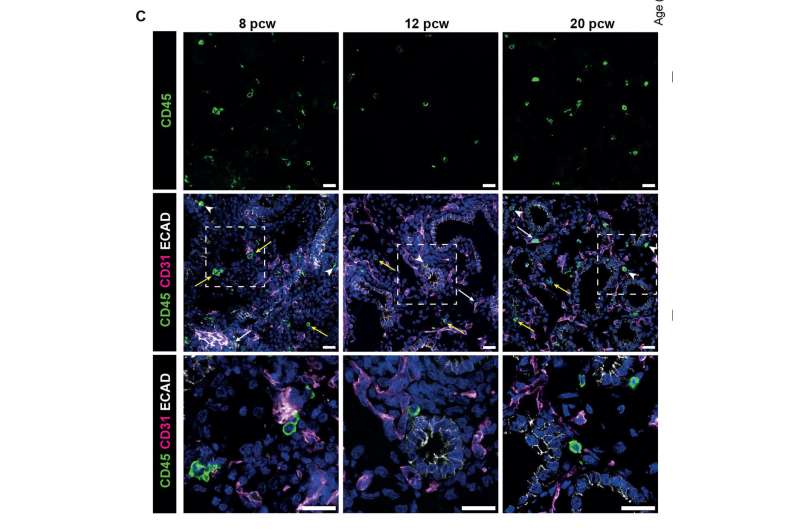This article has been reviewed according to Science X's editorial process and policies. Editors have highlighted the following attributes while ensuring the content's credibility:
fact-checked
peer-reviewed publication
trusted source
proofread
Research shows immune cells shape lung tissue before birth, provides new avenues for treating respiratory diseases

Immune cells play an active and intimate role in directing the growth of human lung tissue during development, researchers find, revolutionizing our understanding of early lung development and the role of immune cells outside of immunity.
The research offers new insights for understanding and treating respiratory conditions, such as chronic obstructive pulmonary disease (COPD). Respiratory conditions account for almost 20% of all deaths in children under five years worldwide.
The work reveals a surprising coordination between the immune and respiratory systems, much earlier in development than previously thought. This discovery raises questions about the potential role of immune cells in other developing organs across the body.
Researchers from the Wellcome Sanger Institute, University College London (UCL) and their collaborators at EMBL's European Bioinformatics Institute used advanced single-cell technologies to map the development of early human lung immune cells over time.
This study has created a first-of-its-kind immune cell atlas of the developing lung. It is part of the international Human Cell Atlas initiative, which is mapping every cell type in the human body, to transform our understanding of health, infection and disease.
The findings, published in Science Immunology, will help shed light on the mechanisms behind childhood lung diseases.
Immune cells make up a substantial portion of the airways and mature lungs, which have critical gas exchange and barrier functions, providing protection against infection of the respiratory tract. However, the roles of immune cells in the developing organ have remained unexplored compared to structural or lining cell types. Recent discoveries confirm the presence of immune cells in human lungs as early as five weeks into development.
To explore whether the immune system might influence how lungs grow, the team studied immune cells in early human lungs from 5 to 22 weeks of development. They used various techniques, including single-cell sequencing and experiments with lung cell cultures, to see if immune cells could affect lung cell development.
They identified key regulators of lung development, including signaling molecule IL-1β and IL-13 that facilitate the coordination of lung stem cells differentiating into specialized mature cell types.
The researchers detected an infiltration of innate, followed by adaptive immune cells. Innate cells included innate lymphoid cells (ILCs), natural killer (NK) cells, myeloid cells and progenitor cells. With respect to adaptive immune cells, as well as T cells, both developing and mature B lineage cells were detected, indicating that the lung environment supports B cell development.
The findings fundamentally change the understanding of the immune and epithelial interactions that are crucial for fetal lung maturation. They also suggest that early immune disturbances could manifest as pediatric lung disease.
These new insights into mechanisms in early lung formation will also contribute to the development of new therapeutic approaches for regenerating damaged lung tissue and restoring lung function.
Dr. Peng He and Dr. Jo Barnes, co-first authors of the study at the Wellcome Sanger Institute and EMBL's European Bioinformatics Institute, and UCL Division of Medicine respectively, said, "By adopting a focused strategy in mapping the immune system, we reveal a symbiotic relationship between immune cells and developing lungs. These detailed insights open the door to potential regenerative therapies in not only the lung, but in other vital human organs."
Dr. Marko Nikolić, senior author of the study at UCL Division of Medicine and honorary consultant in respiratory medicine, said, "We now know immune-epithelial crosstalk is a feature of early lung development. This vital baseline of healthy lung development will help us understand what happens when lung developmental processes get disrupted, for example in preterm births, which can lead to respiratory deficiencies."
Dr. Kerstin Meyer, senior author of the study at the Wellcome Sanger Institute, said, "The active participation of immune cells expands the possibilities for understanding and addressing impaired lung formation. What is super exciting about this mechanism is that it may well apply in other organ systems too."
Dr. Sarah Teichmann, senior author of the study at the Wellcome Sanger Institute and Co-founder of the Human Cell Atlas, said, "If we are to fully understand the root causes of disease, we require a complete view of cells at all stages in the human body. This important contribution towards a comprehensive Human Cell Atlas will be a valuable reference for studying lung diseases."
More information: Josephine Barnes et al, Early human lung immune cell development and its role in epithelial cell fate, Science Immunology (2023). DOI: 10.1126/sciimmunol.adf9988. www.science.org/doi/10.1126/sciimmunol.adf9988




















